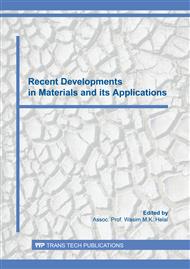[1]
T. Ambrozik, P. Łagowski, Selected failures of internal combustion engine pistons. J. Logistyka 3 (2015) 48-55.
Google Scholar
[2]
A. Ahmed, M.S. Wahab, A.A. Raus, K. Kamarudin, Q. Bakhsh, D. Ali , Mechanical properties, material and design of the automobile piston: an ample review. Indian Journal of Science and Technology 9 (2016) 1-7.
DOI: 10.17485/ijst/2016/v9i36/102155
Google Scholar
[3]
H. Yamagata, The science and technology of materials in automotive engines, Elsevier, (2005).
Google Scholar
[4]
M. Nemat-Alla, Reduction of thermal stresses by developing two-dimensional functionally graded materials. International Journal of Solids and Structures 40(26) (2003) 7339-7356.
DOI: 10.1016/j.ijsolstr.2003.08.017
Google Scholar
[5]
T.A. Enab, Stress concentration analysis in functionally graded plates with elliptic holes under biaxial loadings. Ain Shams Engineering Journal 5(3) (2014) 839-850.
DOI: 10.1016/j.asej.2014.03.002
Google Scholar
[6]
W.M. Helal, D.Y. Shi. FE Analysis of Functionally Graded Material Plate During Debonding Case with Different Boundary Conditions. Key Engineering Materials, Trans Tech Publ. (2015).
DOI: 10.4028/www.scientific.net/kem.627.57
Google Scholar
[7]
T.A. Enab, Behavior of FGM-coated, HA-coated and uncoated femoral prostheses with different geometrical configurations. International Journal of Mechanical and Mechatronics Engineering 16(3) (2016).
Google Scholar
[8]
S. Hu, S., A. Gagnoud, Y. Fautrelle, R. Moreau, X. Li, Fabrication of aluminum alloy functionally graded material using directional solidification under an axial static magnetic field. Scientific reports 8(1) (2018) 1-13.
DOI: 10.1038/s41598-018-26297-5
Google Scholar
[9]
M. Ghamkhar, M.N. Naeem, M. Imran, M. Kamran, C. Soutis, Vibration frequency analysis of three-layered cylinder shaped shell with effect of FGM central layer thickness. Scientific reports 9(1) (2019) 1-13.
DOI: 10.1038/s41598-018-38122-0
Google Scholar
[10]
W.M. Helal, F.C. Jiang, D.Y. Shi. Determination of the Optimum Material Gradient for a Functionally Graded Endodontic Prefabricated Post Using a Sub-Problem Approximation Method. Journal of Biomimetics, Biomaterials and Biomedical Engineering, Trans Tech Publ. (2018).
DOI: 10.4028/www.scientific.net/jbbbe.39.24
Google Scholar
[11]
T.A. Enab, N. Fouda, I. Eldesouky, Numerical study of functionally graded hip implants with different second-generation titanium alloys. Journal of Applied and Computational Mechanics (2020), Articles in Press, Accepted Manuscript, Available Online from 22 April 2020,.
Google Scholar
[12]
G. Knoppers, J. Gunnink, J. Van Den Hout, W. Van Vliet, The reality of functionally graded material products, Intelligent Production Machines and Systems-First I* PROMS Virtual Conference: Proceedings and CD-ROM set, Elsevier. (2005) 467.
Google Scholar
[13]
S.N.S. Jamaludin, F. Mustapha, D.M. Nuruzzaman, S.N. Basri, A review on the fabrication techniques of functionally graded ceramic-metallic materials in advanced composites. Scientific Research and Essays 8(21) (2013) 828-840.
Google Scholar
[14]
M. El-Wazery, A. El-Desouky, A review on functionally graded ceramic-metal materials. Journal of Materials and Environmental Science 6 (2015) 1369-1376.
Google Scholar
[15]
Y. Chen, F. Liou, Additive Manufacturing of Metal Functionally Graded Materials: A Review, Proceedings of the 29th Annual International Solid Freeform Fabrication Symposium. (2018) 1215-1231.
Google Scholar
[16]
A.O. Owoputi, F.L. Inambao, W.S. Ebhota, A Review of Functionally Graded Materials: Fabrication Processes and Applications. International Journal of Applied Engineering Research 13(23) (2018) 16141-16151.
Google Scholar
[17]
N. Radhika, S. Thirumalini, R. Jojith, Development and Properties of Centrifugally Cast Silicon Nitride Reinforced Functionally Graded Copper Matrix Composite. Silicon 11 (2019) 2103-2116.
DOI: 10.1007/s12633-018-0030-y
Google Scholar
[18]
C. Zhang, F. Chen, Z. Huang, M. Jia, G. Chen, Y. Ye, Y. Lin, W. Liu, B. Chen, Q. Shen, L. Zhang, E.J. Lavernia, Additive manufacturing of functionally graded materials: A review. Materials Science and Engineering: A 764 (2019).
DOI: 10.1016/j.msea.2019.138209
Google Scholar
[19]
G. Chirita, D. Soares, F. Silva, Advantages of the centrifugal casting technique for the production of structural components with Al–Si alloys. Materials & Design 29(1) (2008) 20-27.
DOI: 10.1016/j.matdes.2006.12.011
Google Scholar
[20]
E. Jayakumar, J.C. Jacob, T.P.D. Rajan, M.A. Joseph, B.C. Pai, Processing and Characterization of Functionally Graded Aluminum (A319)—SiCp Metallic Composites by Centrifugal Casting Technique. Metallurgical and Materials Transactions A 47(8) (2016) 4306-4315.
DOI: 10.1007/s11661-016-3558-8
Google Scholar
[21]
Y. Watanabe, R. Sato, I.-S. Kim, S. Miura, H. Miura, Functionally graded material fabricated by a centrifugal method from ZK60A magnesium alloy. Materials transactions 46(5) (2005) 944-949.
DOI: 10.2320/matertrans.46.944
Google Scholar
[22]
M.M. Rahvard, M. Tamizifar, S.M.A. Boutorabi, S.G. Shiri, Characterization of the graded distribution of primary particles and wear behavior in the A390 alloy ring with various Mg contents fabricated by centrifugal casting. Materials & Design 56 (2014) 105-114.
DOI: 10.1016/j.matdes.2013.10.070
Google Scholar
[23]
X. Chen, L. Yan, J. Newkirk, F. Liou, Design and Fabrication of Functionally Graded Material from Ti to γ-TiAl by Laser Metal Deposition. Solid Freeform Fabrication 2017: Proceedings of the 28th Annual International (2017) 148-159.
DOI: 10.1007/s11837-017-2582-5
Google Scholar
[24]
M. Chmielewski, K. Pietrzak, Metal-ceramic functionally graded materials–manufacturing, characterization, application. Bulletin of the Polish Academy of Sciences Technical Sciences 64(1) (2016) 151-160.
DOI: 10.1515/bpasts-2016-0017
Google Scholar
[25]
A.G. Arsha, E. Jayakumar, T.P.D. Rajan, V. Antony, B.C. Pai, Design and fabrication of functionally graded in-situ aluminium composites for automotive pistons. Materials & Design 88 (2015) 1201-1209.
DOI: 10.1016/j.matdes.2015.09.099
Google Scholar
[26]
A.G. Arsha, E. Jayakumar, T.P.D. Rajan, V. Antony, B.C. Pai, Processing and characterization of functionally graded in situ aluminum composite. Materials Science Forum, September (2015) 485-488. https://doi.org/10.4028/www.scientific.net/msf.830-831.485.
DOI: 10.4028/www.scientific.net/msf.830-831.485
Google Scholar
[27]
O.S.I. Fayomi, A.P.I. Popoola, N.E. Udoye, Effect of alloying element on the integrity and functionality of aluminium base alloy. Intechopen 13 (2017).
DOI: 10.5772/intechopen.71399
Google Scholar


